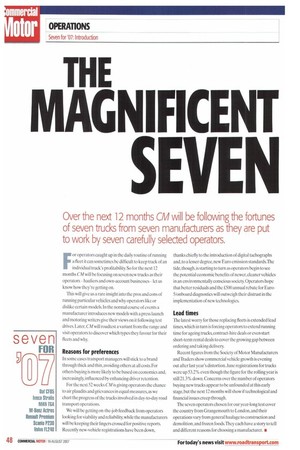THE
Page 48

Page 49

If you've noticed an error in this article please click here to report it so we can fix it.
MAGNIFICENT SEVEN
Over the next 12 months CM will be following the fortunes of seven trucks from seven manufacturers as they are put to work by seven carefully selected operators.
For operators caught up in the daily routine of running a fleet it can sometimes be difficult to keep track of an individual truck's profitability. So for the next 12 months CM will be focusing on seven new trucks as their operators— hauliers and own-account businesses — let us know how they're getting on.
This will give us a rare insight into the pros and cons of running particular vehicles and why operators like or dislike certain models. In the normal course of events a manufacturer introduces new models with a press launch and motoring writers give their views on it following test drives. Later, CM will roadtest a variant from the range and visit operators to discover which types they favour for their fleets and why.
Reasons for preferences In some cases transport managers will stick to a brand through thick and thin, avoiding others at all costs. For others buying is more likely to be based on economics and, increasingly, influenced by enhancing driver retention.
For the next 52 weeks CM is giving operators the chance to air plaudits and grievances in equal measures, as we chart the progress of the trucks involved in day-to-day road transport operations.
We will be getting on-the-job feedback from operators looking for viability and reliability, while the manufacturers will be keeping their fingers crossed for positive reports. Recently new-vehicle registrations have been down, thanks chiefly to the introduction of digital tachographs and, to a lesser degree, new Euro emission standards:The tide, though , is starting to turn as operators begin to see the potential economic benefits of newer, cleaner vehicles in an environmentally conscious society. Operators hope that better residuals and the £500 annual rebate for Euro5/onboard diagnostics will outweigh their distrust in the implementation of new technologies.
Lead times The latest worry for those replacing fleets is extended lead times, which in turn is forcing operators to extend running time for ageing trucks, contract-hire deals or even start short-term rental deals to cover the growing gap between ordering and taking delivery.
Recent figures from the Society of Motor Manufacturers and Traders show commercial vehicle growth is evening out after last year's distortion. June registrations for trucks were up 532% even though the figure for the rolling year is still 21.3% down. Concerns over the number of operators buying new trucks appear to be unfounded at this early stage, but the next 12 months will show if technological and financial issues creep through.
The seven operators chosen for our year-long test cover the country from Grangemouth to London, and their operations vary from general haulage to construction and demolition, and frozen foods.They each have a story to tell and different reasons for choosing a manufacturer. It would have been all too easy to select an operator running 44t trucks between hubs via the motorway and registering above-average fuel figures. For a vehicle built by Daf Trucks, whose products vary from mass fleet market appeal through to 7.5t one-man bands, we've gone that extra mile to find a less typical operator.
Truck manufacturers like to champion the unusual and in operator SM&T VVigham, and its boss Tim Wigharr, the Euro-5 FAS CF85.410 drawbar is exactly that. Registered as a haulage contractor as well as running animal feed, the company runs out of Penrith, Cumbria. The truck is a 6x2 curtainsider prime mover with a Don-Bur triaxle trailer and a Manitou forklift fitted to the rear,
The reason for the specification is volume and versatility. "It's a mobile warehouse. We load it up from Monday, and the driver will park up the trailer and use the prime mover to run to delivery sites; and reload using the Manitou." says VVi gham.
First glance at the line-up reveals a drawbar triaxle bogie pushed right to the back of the chassis and a forklift attached to the back not your usual spec. The trailer was designed by Don-Bur engineers and national account manager Roy Johnson. "There isn't a millimetre of space left on the trailer, The biggest challenge was to make sure it was stable when 'it was running empty," says Johnson.
When loaded, stability with the rear-fitted two-tonne Manitou wasn't an issue, but making the trailer stable when empty meant moving the axles as far back as possible. "We were able to make the front axle a lift to put more weight through the two rear axles," he says, adding that no expense was spared.
The fleet consists of five Daf CF85 430 6x2 tractors, a 6x2 CF75 rigid, a 14t LF55 and a 3.5t LDV, with 10 full-time staff and four part-time.
The trucks are sourced from Solway Daf at Carlisle and Wig ham has chosen Oaf for the past 20 years because of its service. "It has reliability and excellent back-up, and the dealer is on the doorstep," says Wigharn. "We buy AdBlue from Daf, it's the cheapest option, although I'm still not convinced it [SCR] is the best option."
Time will tell.
























































































































































































